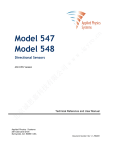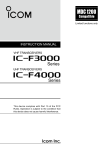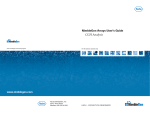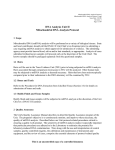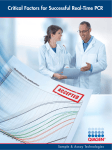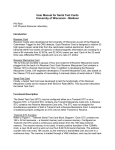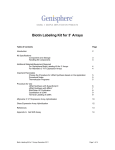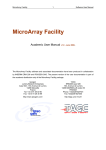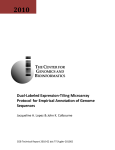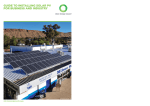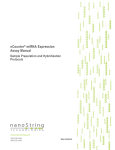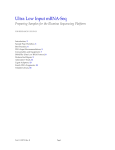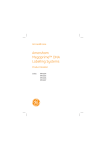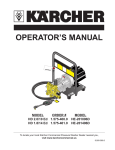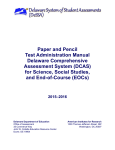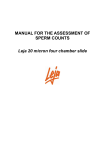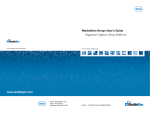Download NimbleGen Arrays User`s Guide: Gene Expression Analysis
Transcript
NimbleGen Arrays User’s Guide Gene Expression Analysis www.nimblegen.com/arraysupport For life science research only. www.nimblegen.com Roche NimbleGen, Inc. 504 S. Rosa Road Madison, WI 53719 USA NimbleGen Arrays User’s Guide Gene Expression Analysis For life science research only. Copyright © 2009 Roche NimbleGen, Inc. All Rights Reserved. Editions Version 1.0, 16 Jan 2007; Version 2.0, 27 Aug 2007; Version 3.0, 21 May 2008; Version 3.1, 24 Oct 2008; Version 3.2, 11 Mar 2009 Service Marks and Trademarks NIMBLEGEN is a trademark of Roche. Other brands, product names, company names, trademarks, and service marks are the properties of their respective holders. BioMicro Systems Inc. is the original equipment manufacturer of the NimbleGen Hybridization System. Restrictions and Liabilities This document is provided “as is” and Roche NimbleGen, Inc. (“Roche NimbleGen”) assumes no responsibility for any typographical, technical, or other inaccuracies in this document. Roche NimbleGen reserves the right to periodically change information that is contained in this document; however, Roche NimbleGen makes no commitment to provide any such changes, updates, enhancements, or other additions to this document to you in a timely manner or at all. OTHER THAN THE LIMITED WARRANTY CONTAINED IN THIS USER GUIDE, ROCHE NIMBLEGEN MAKES NO REPRESENTATIONS, WARRANTIES, CONDITIONS OR COVENANTS, EITHER EXPRESS OR IMPLIED (INCLUDING WITHOUT LIMITATION, ANY EXPRESS OR IMPLIED WARRANTIES OR CONDITIONS OF FITNESS FOR A PARTICULAR PURPOSE, NON-INFRINGEMENT, MERCHANTABILITY, DURABILITY, TITLE, OR RELATED TO THE PERFORMANCE OR NONPERFORMANCE OF ANY PRODUCT REFERENCED HEREIN OR PERFORMANCE OF ANY SERVICES REFERENCED HEREIN). This document might contain references to third party sources of information, hardware or software, products, or services and/or third party web sites (collectively the “Third-Party Information”). Roche NimbleGen does not control, and is not responsible for, any Third-Party Information, including, without limitation the content, accuracy, copyright compliance, compatibility, performance, trustworthiness, legality, decency, links, or any other aspect of Third-Party Information. The inclusion of Third-Party Information in this document does not imply endorsement by Roche NimbleGen of the Third-Party Information or the third party in any way. Roche NimbleGen does not in any way guarantee or represent that you will obtain satisfactory results from using NimbleGen arrays as described herein. The only warranties provided to you are included in the Limited Warranty enclosed with this guide. You assume all risk in connection with your use of NimbleGen arrays. Roche NimbleGen is not responsible nor will be liable in any way for your use of any software or equipment that is not supplied by Roche NimbleGen in connection with your use of NimbleGen arrays. Conditions of Use NimbleGen arrays are intended for life science research only. You are responsible for understanding and performing the protocols described within. Roche NimbleGen does not guarantee any results you may achieve. These protocols are provided as Roche NimbleGen’s recommendations based on its use and experience with NimbleGen arrays. Roche NimbleGen does not guarantee that any NimbleGen array may be used for multiple hybridizations nor does it take any responsibility for your successful satisfaction of the NimbleGen reuse protocol. Reuse of NimbleGen arrays is at your own risk and liability. Table of Contents Chapter 1. Before You Begin..........................................................................................1 What’s New? ...................................................................................................... 1 Components Supplied....................................................................................... 3 Microarray Storage............................................................................................ 3 Protocol Information & Safety ......................................................................... 3 Required Equipment, Labware & Consumables.............................................. 4 NimbleGen Hybridization System............................................................ 5 Microarray Drying System ........................................................................ 5 Scanner ....................................................................................................... 5 Software ...................................................................................................... 5 Standard Laboratory Equipment .............................................................. 6 Consumables & Accessories from Roche NimbleGen ............................. 6 Contents of NimbleGen Kits & Accessories ............................................. 7 Reagents/Consumables from Other Vendors .......................................... 8 Technical Support ............................................................................................. 9 Chapter 2. Sample Preparation & QC........................................................................ 11 Sample Requirements ..................................................................................... 11 Step 1. Spectrophotometric QC of RNA........................................................ 12 Step 2. Bioanalyzer/Gel QC of RNA............................................................... 12 Step 3. First Strand cDNA Synthesis .............................................................. 14 Step 4. Second Strand cDNA Synthesis.......................................................... 15 Step 5. RNase A Cleanup ................................................................................ 16 Step 6. cDNA Precipitation............................................................................. 16 Step 7. Spectrophotometric QC of cDNA...................................................... 17 Step 8. Bioanalyzer/Gel QC of cDNA............................................................. 17 Chapter 3. Sample Labeling ........................................................................................ 19 Chapter 4. Hybridization & Washing.......................................................................... 23 Step 1. Prepare Samples .................................................................................. 23 Step 2. Prepare Mixers .................................................................................... 25 Step 3. Load & Hybridize Samples ................................................................. 27 Step 4. Wash Hybridized Arrays..................................................................... 30 Chapter 5. One-Color Array Scanning ...................................................................... 35 Chapter 6. NimbleScan Data Analysis ...................................................................... 41 Step 1. Burst Multiplex Image (4x72K and 12x135K Arrays Only) .............................................................. 41 Step 2. Import Image....................................................................................... 42 Step 3. Extract Image....................................................................................... 42 Step 4. Confirm Experimental Integrity (4x72K and 12x135K Arrays Only) .............................................................. 43 Performing a Sample Tracking Analysis................................................. 45 Visually Checking STC Features ............................................................. 47 Step 5. Generate an Experimental Metrics Report ........................................ 48 Step 6. Create Pair Reports ............................................................................. 52 Step 7. Analyze Data........................................................................................ 52 Chapter 7. Troubleshooting ......................................................................................... 55 Sample Quality ................................................................................................ 55 Labeling............................................................................................................ 56 Hybridization................................................................................................... 57 Scanning........................................................................................................... 58 Sample Tracking Controls (STCs) ................................................................. 62 Data Analysis ................................................................................................... 63 Appendix A. Expression Data Analysis ..................................................................... 65 Step 1. Install the Necessary Software ............................................................ 65 Step 2. Import Your Expression Data ............................................................ 65 Step 3. Analyze Your Expression Data ........................................................... 66 Appendix B. Limited Warranty .................................................................................... 69 ii | NimbleGen Arrays User’s Guide: Gene Expression Analysis v3.2 Chapter 1. Before You Begin This user’s guide describes the processes for analyzing gene expression using these NimbleGen array formats: 385K (385,000 probes) 4x72K (4 x 72,000 probes) 12x135K (12 x 135,000 probes) The first step involves creating cDNA from eukaryotic total RNA or poly-A+ RNA (mRNA) and cDNA from prokaryotic total RNA using the Invitrogen SuperScript Double-Stranded cDNA Synthesis Kit. The second step requires labeling the cDNA using a NimbleGen One-Color DNA Labeling Kit and subsequent hybridization to a NimbleGen array using a NimbleGen Hybridization System. Subsequent steps include washing, drying, and scanning the array. Finally, data is extracted from the scanned image and analyzed for gene expression levels. What’s New? Version 3.0 of this user’s guide includes instructions on using NimbleGen 12x135K arrays, which enable you to hybridize up to 12 independent samples on a single slide, for gene expression experiments. It also includes details about the newly configured NimbleGen kits for array hybridization and processing (refer to pages 6 - 7 for more information on the available kits). Version 3.1 describes how to seal the fill and vent ports of HX12 mixers using mixer multi-port seals. As of October 2008, mixer multi-port seals are included with HX12 mixers instead of mixer port seals. Refer to page 29 for instructions. This version also includes details about the experimental metric features available in the NimbleScan v2.5 software and a troubleshooting chapter. Version 3.2 includes instructions on how to process samples using the NimbleGen One-Color DNA Labeling Kit and NimbleGen Microarray Dryer. Step Process Time QC of RNA 0.5h First Strand cDNA Synthesis 0.5h 1hr Second Strand cDNA Synthesis 0.5h 2hr cDNA Cleanup & QC 1.5h cDNA Labeling 0.5h 2hr Cy3-cDNA Cleanup & Quantitation 1h Microarray Hybridization 0.5h – 1h Overnight Microarray Washing 0.5h Microarray Scanning 0.5h Data Analysis 385K & 4x72K Arrays: 0.5h 12x135K Arrays: 2h Figure 1: Workflow for NimbleGen Gene Expression Analysis. Steps in the process and estimated time for each step, based on the processing of one slide, are shown in the boxes. Incubation times are indicated beneath the appropriate process times. 2| NimbleGen Arrays User’s Guide: Gene Expression Analysis v3.2 Components Supplied 385K Array Component NimbleGen Arrays 4x72K Array 12x135K Array As ordered NimbleGen Mixers One X1 mixer is ordered separately from the 385K array One X4 mixer is provided per 4x72K array One HX12 mixer is provided per 12x135K array Mixer Port Seals or Mixer Multi-port Seals Mixer port seals are provided with X1 mixers Mixer multi-port seals are provided with X4 mixers Mixer multi-port seals are provided with HX12 mixers NimbleGen Arrays User’s Guide: Gene Expression Analysis One booklet NimbleGen Design Files One CD/DVD Microarray Storage Store NimbleGen microarrays in a desiccator at room temperature until ready to use. Protocol Information & Safety Wear gloves and take precautions to avoid sample contamination. To avoid RNA degradation, Roche NimbleGen recommends using RNase ZAP to eliminate contamination from work surfaces. Keep RNA on ice at all times. Keep RNase A in a designated work area and use designated pipettes and tips to prevent RNase A contamination throughout the lab. Change gloves after handling RNase A and clean work area with RNase ZAP immediately after use. NimbleGen Arrays User’s Guide: Gene Expression Analysis v3.2 |3 Phenol:chloroform:isoamyl alcohol is dangerous and should be handled with caution. Wear the correct personal protective equipment when handling this chemical. Refer to MSDS for more information. Cy dyes are light sensitive. Be sure to minimize light exposure of the dyes during use and store in the dark immediately after use. Cy dyes are ozone sensitive. Take the necessary precautions to keep atmospheric ozone levels below 20ppb (parts per billion). Cy dyes are humidity sensitive. Take the necessary precautions to keep humidity levels below 40%. Roche NimbleGen has found that using VWR water and DTT for all posthybridization washes results in higher signal from Cy dyes. Roche NimbleGen recommends using a NanoDrop Spectrophotometer for quantifying and characterizing nucleic acid samples because this instrument requires only 1.5μl of sample for analysis. Perform all centrifugations at room temperature unless indicated otherwise. Required Equipment, Labware & Consumables You assume full responsibility when using the equipment, labware, and consumables described below. These protocols are designed for the specified equipment, labware, and consumables. 4| NimbleGen Arrays User’s Guide: Gene Expression Analysis v3.2 NimbleGen Hybridization System Choose between the following: Equipment Supplier Process Quantity Item Number 05223652001 (110V) NimbleGen Hybridization System 4* Roche NimbleGen 4 slides 05223679001 (220V) 05223687001 (110V) NimbleGen Hybridization System 12* Roche NimbleGen 12 slides 05223695001 (220V) * NimbleGen Hybridization Systems include an accessory kit that contains a Precision Mixer Alignment Tool (PMAT), Mixer Disassembly Tool, Mixer Brayer, System Verification Assemblies, replacement O-rings, and forceps. Microarray Drying System Equipment NimbleGen Microarray Dryer Supplier Roche NimbleGen Process Quantity 24 slides Item Number 05223636001 (110V) 05223644001 (220V) Scanner Equipment Supplier Item Number GenePix 4000B Molecular Devices NA Software Program Supplier Item Number NimbleScan v2.5 Roche NimbleGen 05225035001 (Individual License) 05225043001 (Site License) ArrayStar® v2.1 (trial version) Roche NimbleGen NimbleGen Arrays User’s Guide: Gene Expression Analysis v3.2 05225060001 |5 Standard Laboratory Equipment Equipment Supplier Item Number NimbleGen Compressed Gas Nozzle Roche NimbleGen 05223628001 Bioanalyzer Agilent 2100 Desiccator Multiple Vendors Heat block (capable of temperatures to 98°C) Multiple Vendors Microcentrifuge (12,000 x g capability) Multiple Vendors Microman M10 Pipette (recommended for 4x72K and 12x135K arrays) Gilson F148501 Microman M100 Pipette Gilson F148504 Spectrophotometer NanoDrop ND-1000 SpeedVac Thermo Savant Thermocycler Multiple Vendors Vortex Mixer Multiple Vendors (recommended for 385K arrays) Consumables & Accessories from Roche NimbleGen Package Size / Process Quantity Item Number NimbleGen X1 Mixer (for 385K arrays; includes mixer port seals) 10 mixers 05223725001 NimbleGen X4 Mixer (for 4x72K arrays; includes mixer multi-port seals) 10 mixers 05223733001 NimbleGen HX12 Mixer (for 12x135K arrays; includes mixer multi-port seals) 10 mixers 05223768001 NimbleGen One-Color DNA Labeling Kit 20 Cy3 labeling reactions 05223555001 NimbleGen Hybridization Kit 100 hybridizations using X1 mixers 05223474001 Component 160 hybridizations using X4 mixers 120 hybridizations using HX12 mixers 6| NimbleGen Arrays User’s Guide: Gene Expression Analysis v3.2 Component Package Size / Process Quantity NimbleGen Hybridization Kit, LS (Large Scale) 300 hybridizations using X1 mixers Item Number 05223482001 480 hybridizations using X4 mixers 480 hybridizations using HX12 mixers NimbleGen Sample Tracking Control Kit 120 hybridizations for 4x72K arrays or 12x135K arrays 05223512001 NimbleGen Wash Buffer Kit 10 washes (processing 4 slides per wash) 05223504001 NimbleGen Array Processing Accessories 05223512001 Contents of NimbleGen Kits & Accessories Kit Contents NimbleGen One-Color DNA Labeling Kit Nuclease-free Water (2 x vial 1) Random Primer Buffer (vial 2) Cy3-Random Nonamers (vial 3) Klenow Fragment (3’->5’ exo-) 50U/µl (vial 4) 10mM dNTP Mix (vial 5) Stop Solution (0.5M EDTA) (vial 6) 5M NaCl (vial 7) NimbleGen Hybridization Kit and NimbleGen Hybridization Kit, LS 2X Hybridization Buffer Hybridization Component A Alignment Oligo1 NimbleGen Sample Tracking Control Kit Sample Tracking Controls2 NimbleGen Wash Buffer Kit 10X Wash Buffer I 10X Wash Buffer II 10X Wash Buffer III 1M DTT NimbleGen Arrays User’s Guide: Gene Expression Analysis v3.2 |7 Kit Contents NimbleGen Array Processing Accessories Slide Rack Wash Tanks Slide Containers 1 The Alignment Oligo is a mixture of Cy3- and Cy5-labeled 48mer oligonucleotides that hybridize to alignment features on NimbleGen arrays. It is required for proper extraction of array data from the scanned image. 2 Twelve Sample Tracking Controls (STCs) are provided. Each STC is a Cy3-labeled 48mer oligonucleotide. When a unique STC is added to each sample before hybridization to a multiplex array, the STC can be used to confirm that the correct sample was hybridized to each array. Reagents/Consumables from Other Vendors Component Supplier Package Size Item Number β-Mercaptoethanol Sigma Aldrich 25ml M3148 0.5M EDTA Sigma Aldrich 100ml E7889 5mg/ml Glycogen Ambion 5 x 1ml 9510 7.5M Ammonium Acetate Sigma Aldrich 1 liter A2706 Absolute Ethanol Sigma Aldrich 500ml E702-3 Compressed Inert Gas* Multiple Vendors CP10 Pipette Tips (for 4x72K and 12x135K arrays) Gilson 192 tips F148412 960 tips F148312 CP100 Pipette Tips (for 385K arrays) Gilson 192 tips F148414 960 tips F148314 Isopropanol Sigma Aldrich 500ml I-9516 Oligo dT Primer Multiple Vendors Phase Lock tubes (Light 1.5ml) Fisher Scientific 200 tubes FP2302800 Phenol:chloroform: isoamyl alcohol (25:24:1) Ambion 100ml 9730 Random Primer Multiple Vendors RNase A Solution Promega 4mg/ml A7973 8| NimbleGen Arrays User’s Guide: Gene Expression Analysis v3.2 Component Supplier Package Size Item Number SuperScript Double-Stranded cDNA Synthesis Kit Invitrogen 10 reactions 11917-010 50 reactions 11917-020 Water: reagent grade, ACS, nonsterile, type 1 VWR 2.5 gallon RC915025 Cotton Swabs Multiple Vendors * Roche NimbleGen recommends using the NimbleGen Compressed Gas Nozzle to gently blow compressed inert gas across arrays to remove any dust or debris. The use of canned aerosol compressed air for this purpose is not recommended and could compromise array and data quality. Technical Support If you have questions, contact your Roche NimbleGen Account Manager or Roche Microarray Technical Support. Go to www.nimblegen.com/arraysupport for contact information. NimbleGen Arrays User’s Guide: Gene Expression Analysis v3.2 |9 Notes 10 | NimbleGen Arrays User’s Guide: Gene Expression Analysis v3.2 Chapter 2. Sample Preparation & QC Chapter 2 describes how to create cDNA from eukaryotic total RNA or poly-A+ RNA (mRNA), and cDNA from prokaryotic total RNA using Invitrogen SuperScript Double-Stranded cDNA Synthesis Kit. Sample Requirements High-quality RNA is required for optimal cDNA synthesis yield and cDNA labeling for microarray hybridization. Suggested RNA isolation methods successfully used with the NimbleGen Gene Expression platform are the Qiagen RNeasy® Kit (Catalog No. 74104) and Invitrogen TRIzol® reagent (Catalog No. 15596-026). Roche NimbleGen recommends starting with the following amounts of total RNA or poly-A+ RNA amounts for each hybridization: Array Format Eukaryotes Prokaryotes 385K arrays 10µg total RNA 10µg total RNA 1µg poly-A+ RNA 4x72K arrays 10µg total RNA 1µg poly-A+ RNA 10µg total RNA 12x135K arrays 10µg total RNA 1µg poly-A+ RNA 10µg total RNA Step 1. Spectrophotometric QC of RNA Prior to synthesizing cDNA, verify that the RNA samples are of sufficient purity to proceed with cDNA synthesis. 1. Quantitate each RNA sample according to the following formula: RNA Concentration (μg/ml) = A260 x 40 x Dilution Factor RNA samples must have a concentration ≥ 1.0μg/μl. 2. Verify all samples meet the following requirements: • • A260/A280 ≥ 1.8 A260/A230 ≥ 1.8 Step 2. Bioanalyzer/Gel QC of RNA Verify RNA samples are of sufficient molecular weight. Roche NimbleGen recommends the use of an Agilent 2100 Bioanalyzer, because the required sample size is very small. If a Bioanalyzer is not available, use a denaturing agarose gel. 1. Transfer 250ng total RNA or 250ng poly-A+ RNA to a sterile microcentrifuge tube. Store the remainder of your sample on ice or at -80°C. 2. Analyze samples using the Agilent Bioanalyzer and RNA 6000 Nano Assay Reagent Kit. 3. Compare the Bioanalyzer traces to those traces in Figures 2 and 3. Degraded samples appear as significantly lower intensity traces with the main peak area shifted to the left and typically exhibit much more noise in the trace. Note: If using a denaturing agarose gel, one reagent source is Ambion NorthernMax® reagents for northern blotting. This kit’s first section includes reagents and instructions for using denaturing agarose gels. You can also purchase reagents individually. Compare gel images to the Bioanalyzer electropherogram images. Samples exhibiting degradation should not be carried through labeling and hybridization because there is an unacceptable risk of poor results. 12 | NimbleGen Arrays User’s Guide: Gene Expression Analysis v3.2 Degraded mRNA Fluorescence Units Degraded Total RNA Time (Seconds) Time (Seconds) Figure 2: Example Traces for Degraded RNA Samples from a Eukaryotic Organism Good Total RNA Good mRNA Fluorescence Units 28S 18S Time (Seconds) Time (Seconds) Figure 3: Example Traces for Non-degraded RNA Samples from a Eukaryotic Organism Note: Your traces could look different than these examples. Compare your traces to reference traces for the organism being researched. NimbleGen Arrays User’s Guide: Gene Expression Analysis v3.2 | 13 Step 3. First Strand cDNA Synthesis Use the Invitrogen Superscript Double-Stranded cDNA Synthesis Kit to synthesize double-stranded cDNA. 1. Thaw and maintain the following components on ice. Combine components in a 0.2ml tube on ice according to the following tables. Note: Roche NimbleGen does not recommend a vendor for oligo dT or random hexamer primer. Follow your preferred vendor’s recommendation for the amount of primer to use. For example, Invitrogen recommends using 1μl of 100pmol/μl primer. Total RNA Amount Poly-A+ RNA (mRNA) Amount RNA 10µg 1µg oligo dT Primer 1µl 1µl Eukaryotic Source of RNA DEPC Water Total Prokaryotic Source of RNA To volume To volume 11µl 11µl Total RNA Amount RNA 10µg Random Hexamer Primer 1µl DEPC Water Total To volume 11µl 2. Heat sample(s) to 70°C for 10 minutes in a thermocycler. Briefly spin tubes in a microcentrifuge and place them in an ice-water slurry for 5 minutes. 3. Add the following to each sample tube. (You can use a master mix when preparing multiple samples.) Component 14 | Volume Reaction volume from step 2 11µl 5X First Strand Buffer 4µl 0.1M DTT 2µl 10mM dNTP Mix 1µl Total 18µl NimbleGen Arrays User’s Guide: Gene Expression Analysis v3.2 4. Mix gently (avoid vortexing). Briefly spin the tube(s) in a microcentrifuge. 5. Place sample(s) in a thermocycler set at 42°C for 2 minutes. 6. Add 2μl of SuperScript II and mix gently (avoid vortexing). 7. Incubate the sample(s) at 42°C for 60 minutes. 8. STOP POINT: Briefly spin the tube(s) in a microcentrifuge. Place the sample(s) on ice until the second strand synthesis. You can store the sample(s) overnight at -20°C. Step 4. Second Strand cDNA Synthesis 1. Add the following components to the first strand reaction(s) in the indicated order; you can use a master mix. Keep tube(s) on ice or in a PCR tube chiller rack. Component Volume Reaction volume from Step 3.8 20µl DEPC Water 91µl 5X Second Strand Buffer 30µl 10mM dNTP Mix 3µl 10U/µl DNA Ligase 1µl 10U/µl DNA Polymerase I 4µl 2U/µl RNase H 1µl Total 150µl 2. Mix gently (avoid vortexing). Briefly spin the tube(s) in a microcentrifuge. Incubate at 16°C for 2 hours. 3. Add 2μl of 5U/μl T4 DNA polymerase to each reaction. Incubate at 16°C for an additional 5 minutes. Do not allow the reaction temperature to exceed 16°C during this step. 4. STOP POINT: Place the sample(s) on ice or in a PCR tube chiller rack, and add 10μl of 0.5M EDTA. You can store samples overnight at -20°C. NimbleGen Arrays User’s Guide: Gene Expression Analysis v3.2 | 15 Step 5. RNase A Cleanup 1. Add 1μl of 4mg/ml RNase A solution to the tubes from Step 4.4. Important: Use caution when working with RNase A. Change gloves after use. Use RNase ZAP to clean work area surfaces. 2. Mix gently (avoid vortexing). Briefly spin the tube(s) in a microcentrifuge. 3. Incubate sample(s) at 37°C for 10 minutes. 4. During incubation, centrifuge Phase Lock tube(s) at 12,000 x g for 2 minutes. Label one Phase Lock tube and two 1.5ml centrifuge tubes for each sample with sample names. 5. Add 163μl of phenol:chloroform:isoamyl alcohol to one set of 1.5ml centrifuge tubes. 6. Transfer the sample(s) to the tube(s) containing phenol:chloroform:isoamyl alcohol. Vortex well. 7. Transfer samples with the phenol:chloroform:isoamyl alcohol to Phase Lock tubes. 8. Centrifuge at 12,000 x g for 5 minutes. 9. Transfer the upper, aqueous layer to a clean 1.5ml tube. Step 6. cDNA Precipitation 1. Add 16μl (0.1 volume of Step 5.9) of 7.5M ammonium acetate to the samples. Mix by repeated inversion. Briefly spin the tube(s) in a microcentrifuge. 2. Add 7μl of 5mg/ml glycogen to the samples. Mix by repeated inversion. Briefly spin the tube(s) in a microcentrifuge. 3. Add 326μl (2 volumes of Step 5.9) of ice-cold absolute ethanol to the samples. Mix by repeated inversion. 4. Centrifuge at 12,000 x g for 20 minutes. 5. Remove supernatant. Take care not to disturb the pellet. 16 | NimbleGen Arrays User’s Guide: Gene Expression Analysis v3.2 6. Add 500μl of ice-cold 80% ethanol (v/v). Mix by repeated inversion. 7. Centrifuge tubes at 12,000 x g for 5 minutes. 8. Remove supernatant. Take care not to disturb the pellet. 9. Repeat steps 6 - 8. 10. Dry the pellet in a SpeedVac. 11. Rehydrate samples with 20μl of VWR water. Step 7. Spectrophotometric QC of cDNA 1. Quantitate each cDNA sample according to the following formula: cDNA Concentration (μg/ml) = A260 x 50 x Dilution Factor 2. Verify that all samples meet the following requirements: • • • Concentration ≥ 100ng/μl A260/A280 ≥ 1.8 A260/A230 ≥ 1.8 Step 8. Bioanalyzer/Gel QC of cDNA 1. Transfer 250ng cDNA to a sterile microcentrifuge tube. Store the remainder of your sample on ice or at -20°C. 2. Analyze the samples using the Agilent Bioanalyzer. 3. Compare the Bioanalyzer traces to the traces displayed below. Verify that all samples meet the following requirement for acceptance: • • Median size ≥ 400bp when compared to a DNA ladder. Looks similar to the examples of good cDNA sample traces displayed below. Note: If using an agarose gel, compare the gel images to the Bioanalyzer’s electropherogram images. Samples exhibiting degradation should not be carried through labeling and hybridization because there is an unacceptable risk of poor results. NimbleGen Arrays User’s Guide: Gene Expression Analysis v3.2 | 17 Fluorescence Units Time (Seconds) Time (Seconds) Figure 4: Example Traces Showing Good cDNA from a Eukaryotic Organism Note: Your traces could look different than these examples. Compare your traces to reference traces for the organism being researched. 18 | NimbleGen Arrays User’s Guide: Gene Expression Analysis v3.2 Chapter 3. Sample Labeling Chapter 3 describes how to label your cDNA samples using a NimbleGen OneColor DNA Labeling Kit. Be aware of the following when using these kit contents: Aliquot dNTPs and Cy primer into single-use amounts. 5M NaCl could precipitate. Vortex if necessary. 1. Prepare the following solution: All Array Formats Random Primer Buffer Random Primer Buffer (vial 2) 998.25µl β-Mercaptoethanol 1.75µl Total 1ml Notes Prepare fresh buffer each time primers are resuspended. 2. Briefly centrifuge Cy3-Random Nonamers (vial 3) because some of the product could have dislodged during shipping. Dilute the primer in 924μl of Random Primer Buffer with β-Mercaptoethanol. Aliquot to 40μl individual reaction volumes in 0.2ml thin-walled PCR tubes and store at -20°C, protected from light. Note: Do not store diluted primers longer than 4 months. 3. Assemble the following components in separate 0.2ml thin-walled PCR tubes: Component All Array Formats cDNA 1µg Diluted Cy3-Random Nonamers from step 2 40µl Nuclease-free Water (vial 1) Total To volume 80µl 4. Heat-denature samples in a thermocycler at 98°C for 10 minutes. Quickchill in an ice-water bath for 10 minutes. Important: Quick-chilling after denaturation is critical for high-efficiency labeling. 5. Prepare the following dNTP/Klenow master mix for each sample prepared in step 4. Important: Keep all reagents and dNTP/Klenow master mix on ice. Do not vortex after addition of Klenow. dNTP/Klenow Master Mix: Recipe per Sample All Array Formats 10mM dNTP Mix (vial 5) 10µl Nuclease-free Water (vial 1) 8µl Klenow Fragment (3’->5’ exo-) 50U/µl (vial 4) 2µl Total 20µl 6. Add 20μl of the dNTP/Klenow master mix prepared in step 5 to each of the denatured samples prepared in step 4. Keep on ice. Component Important! All Array Formats Reaction volume from step 4 80µl dNTP/Klenow Master Mix 20µl Total 100µl 7. Mix well by pipetting up and down 10 times. Important: Do not vortex after addition of Klenow. 8. Quick-spin to collect contents in bottom of the tube. 9. Incubate at 37°C for 2 hours in a thermocycler with heated lid, protected from light. 10. Stop the reaction by addition of the Stop Solution (0.5M EDTA). Component 20 | All Array Formats Reaction volume from step 6 100µl Stop Solution (0.5M EDTA) (vial 6) 10µl Total 110µl NimbleGen Arrays User’s Guide: Gene Expression Analysis v3.2 11. Add 5M NaCl to each tube. Component All Array Formats Reaction volume from step 10 110µl 5M NaCl (vial 7) 11.5µl Total 121.5µl 12. Vortex briefly, spin, and transfer the entire contents to a 1.5ml tube containing isopropanol. Component All Array Formats Reaction volume from step 11 121.5µl Isopropanol 110µl Total 231.5µl 13. Vortex well. Incubate for 10 minutes at room temperature, protected from light. 14. Centrifuge at 12,000 x g for 10 minutes. Remove supernatant with a pipette. Pellet should be pink. 15. Rinse pellet with 500μl 80% ice-cold ethanol. Dislodge pellet from tube wall by pipetting a few times. 16. Centrifuge at 12,000 x g for 2 minutes. Remove supernatant with a pipette. 17. Dry contents in a SpeedVac on low heat until dry (approximately 5 minutes), protected from light. 18. STOP POINT: Proceed to step 19, or store labeled samples at -20°C (up to 1 month), protected from light. Important! 19. Spin tubes briefly prior to opening. Rehydrate pellets in 25μl Nuclease-free Water (vial 1) per reaction. 20. Vortex for 30 seconds and quick-spin to collect contents in bottom of the tube. Continue to vortex or let sit at room temperature, protected from light, for approximately 5 minutes or until the pellet is completely rehydrated, then vortex again and quick-spin. NimbleGen Arrays User’s Guide: Gene Expression Analysis v3.2 | 21 21. Quantitate each sample using the following formula: Concentration (μg/ml) = A260 x 50 x Dilution Factor Note: The NanoDrop user’s manual specifies that in the Nucleic Acid module the maximum accurate reading is 3,700ng/μl, and in the Microarray module, the maximum accurate reading is 700ng/μl. Roche NimbleGen recommends using the spectrophotometer in the Nucleic Acid module. If sample concentration exceeds these values, dilute sample appropriately and requantitate. 22. Based on the concentration, calculate the volume of Cy3-labeled cDNA sample required for each hybridization per the following table and aliquot in a 1.5ml tube: Sample Requirements* Cy3-labeled cDNA Sample 385K Array 4x72K Array 12x135K Array Prok: 3µg Prok: 2µg Prok: 2µg Euk: 6µg Euk: 4µg Euk: 4µg * Prok = Prokaryote; Euk = Eukaryote 23. Dry contents in a SpeedVac on low heat, protected from light. 24. STOP POINT: Proceed to Chapter 4, or store labeled samples at -20°C (up to 1 month), protected from light. 22 | NimbleGen Arrays User’s Guide: Gene Expression Analysis v3.2 Chapter 4. Hybridization & Washing Chapter 4 describes the NimbleGen protocol for sample hybridization and washing. Be aware of the following: The hybridization protocol requires a NimbleGen Hybridization System. Refer to its user’s guide for specific instructions on its use. The hybridization protocol requires adhering a NimbleGen mixer to the microarray slide. Refer to the package label to identify the mixer design. Some instructions in the protocol are specific to the mixer design. The Alignment Oligo and Sample Tracking Controls (STCs) provided in the NimbleGen Hybridization and Sample Tracking Control Kits, respectively, are labeled with Cy dye, which are sensitive to photobleaching and freezethawing. After thawing stock tubes for the first time, aliquot the Alignment Oligo and STCs into single-use volumes and freeze at -20°C. Protect tubes from light. Step 1. Prepare Samples 1. Set the Hybridization System to 42°C. With the cover closed, allow at least 3 hours for the temperature to stabilize. Note: Be aware that the temperature of the Hybridization System may fluctuate during stabilization. 2. Resuspend the dried sample pellet in VWR water (for 385K arrays) or appropriate Sample Tracking Control (for 4x72K and 12x135K arrays) according to the following table. Each sample to be hybridized to a 4x72K or 12x135K array should be resuspended in a unique STC. Record which STC is used for each sample. Each Sample for a 4x72K Array Each sample for a 12x135K Array Water Sample Tracking Control Sample Tracking Control 5µl 3.3µl 3.3µl 385K Array Component Reagent for resuspension Volume to add to Cy-labeled Sample from step 23 in Chapter 3 3. Vortex well and spin to collect contents in bottom of the tube. 4. Using components from a NimbleGen Hybridization Kit, prepare the hybridization solution master mix according to the following table. For 4x72K and 12x135K arrays, the amount listed is sufficient to hybridize all 4 or 12 subarrays on a slide. To hybridize multiple slides, adjust the amounts accordingly. Hybridization Solution Master Mix to Hybridize a Single Slide 385K Array 4x72K Array 12x135K Array 2X Hybridization Buffer 11.8µl 29.5µl 88.5µl Hybridization Component A 4.7µl 11.8µl 35.4µl Alignment Oligo 0.5µl 1.2µl 3.6µl Total 17µl 42.5µl 127.5µl 5. Add the appropriate amount of hybridization solution to each sample according to the following table: 385K Array Component Each Sample for a 4x72K Array Each Sample for a 12x135K Array Resuspended sample from step 2 5µl 3.3µl 3.3µl Hybridization solution from step 4 13µl 8.7µl 8.7µl Total 18µl 12µl 12µl 6. Vortex well (approximately 15 seconds) and spin to collect contents in bottom of the tube. Incubate at 95°C for 5 minutes, protected from light. 7. Place tubes at 42°C (in the Hybridization System sample block or heat block) for at least 5 minutes or until ready for sample loading. Vortex and spin prior to loading. 24 | NimbleGen Arrays User’s Guide: Gene Expression Analysis v3.2 Step 2. Prepare Mixers 1. Locate the appropriate mixer. Remove from its package. Note: For best results, use the NimbleGen Compressed Gas Nozzle to gently blow compressed inert gas across the mixer and slide to remove any dust or debris. The use of canned aerosol compressed air for this purpose is not recommended and could compromise array and data quality. Load samples within 30 minutes of opening the vacuum-packaged mixer to prevent the formation of bubbles during loading and/or hybridization. Array Format Mixer 385K array X1 mixer 4x72K array X4 mixer 12x135K array HX12 mixer 2. Position the Precision Mixer Alignment Tool (PMAT) with its hinge on the left. Open the PMAT (Figure 5). 3. Snap the mixer onto the two alignment pins on the lid of the PMAT with the tab end of the mixer toward the inside hinge and the mixer’s adhesive gasket facing outward (Figure 5). 4. While pushing back the plastic spring with a thumb, place the slide in the base of the PMAT so that the barcode is on the right and the corner of the slide sits against the plastic spring. The NimbleGen logo and barcode number should be readable. Remove your thumb and make sure the spring is engaging the corner of the slide and the entire slide is registered to the edge of the PMAT to the rightmost and closest to you. In addition, be sure that the slide is lying flat against the PMAT. Gently blow compressed inert gas across the mixer and slide to remove dust. Note: Take care to align the slide correctly in the PMAT. Incorrectly aligned slides may result in inaccurate attachment of the mixer and may not fit well into the Mixer Disassembly Tool used to remove the mixers after hybridization. 5. Using forceps, remove the backing from the adhesive gasket of the mixer and close the lid of the PMAT so that the gasket makes contact with the slide. NimbleGen Arrays User’s Guide: Gene Expression Analysis v3.2 | 25 6. Lift the lid by grasping the long edges of the PMAT while simultaneously applying pressure with a finger through the window in the lid of the PMAT to free the mixer-slide assembly from the alignment pins. PMAT Mixer Alignment Pins Plastic Spring Slide Barcode Register slide to this edge Figure 5: PMAT with X1 Mixer and Slide 7. Remove the mixer-slide assembly from the PMAT. 8. Place the mixer-slide assembly on the back of a 42°C heating block to facilitate adhesion of the mixer to the slide. 9. Rub the Mixer Brayer over the mixer with moderate pressure to adhere the adhesive gasket and remove any bubbles. For X1 mixers, start in the center of the array and rub outwards. For X4 and HX12 mixers, first use a corner of the Mixer Brayer to rub the borders between the subarrays, and then rub around the outside of the subarrays. The adhesive gasket will become clear when fully adhered to both surfaces. 10. Place the mixer-slide assembly in the slide bay of the Hybridization System. 26 | NimbleGen Arrays User’s Guide: Gene Expression Analysis v3.2 Step 3. Load & Hybridize Samples 1. Refer to the appropriate diagram below when loading sample: Barcode Fill Port Vent Port Figure 6: X1 Mixer and Slide for a 385K Array Fill Ports A02 A03 A01 A04 Barcode A01 A02 A03 A04 Vent Ports Figure 7: X4 Mixer and Slide for a 4x72K Array NimbleGen Arrays User’s Guide: Gene Expression Analysis v3.2 | 27 Fill Ports A12 Fill Ports A11 A10 A09 A08 A07 A06 A05 A04 A03 A01 Barcode A02 A01 A02 A03 A04 A05 A06 A07 A08 A09 A10 A11 A12 A11 A12 Vent Ports Vent Ports Figure 8: HX12 Mixer for a 12x135K Array. The enlarged image shows the positioning of fill and vent ports on the HX12 mixer. 2. Keep the following in mind before loading sample: • Leave residual volume in the sample tube to avoid bubbles. The volumes listed in the table below account for this additional amount. • After aspirating the designated sample volume, inspect the pipette tip for air bubbles. Dispense and reload the pipette if bubbles exist. Keep the following in mind when loading sample: • Keep the pipette tip perpendicular to the slide to avoid possible leakage at the fill port. • Apply gentle pressure of the tip into the port to ensure a tight seal while loading the sample. Component Sample Loading Volume Pipette Tip * 385K Array 4x72K Array 12x135K Array 16µl 8µl 6µl CP100 CP10* CP10* The CP10 tip is thin and flexible. Place the thumb and forefinger of your free hand on the tip to guide it into the port. 28 | NimbleGen Arrays User’s Guide: Gene Expression Analysis v3.2 3. Using the appropriate Gilson Microman pipette, slowly dispense the appropriate sample volume into the fill port. Load samples and seal mixer ports as described below for each array format: • For 385K arrays: a. Load sample into the fill port. Dry any overflow from the fill and vent ports with a cotton swab after loading the array. b. Use one mixer port seal to cover the fill port and another to cover the vent port on X1 mixer. Press the mixer port seal using uniform pressure across the seal to adhere. c. • Use forceps to press the mixer port seal around the fill and vent ports to ensure it is adhered in those areas. For 4x72K arrays: a. Load sample into the A01 fill port. Dry any overflow from the fill and vent ports with a cotton swab after loading. Repeat loading samples into the A02 - A04 fill ports, using a fresh cotton swab for drying the ports for each array. b. Use one mixer multi-port seal to cover all fill and vent ports on X4 mixers. Press the mixer multi-port seal, using uniform pressure across the seal to adhere. c. • Use forceps to press the mixer multi-port seal around the fill and vent ports to ensure it is adhered in those areas. For 12x135K arrays: a. Load sample into the A01 fill port. Due to the close proximity of the fill and vent ports, do not overfill the arrays. Load sample until it enters the vent port channel. Do not allow sample to come to the surface of the HX12 mixer. If overflow occurs, dry the overflow from the fill and vent ports with a cotton swab after loading. Repeat loading sample into the A02 - A06 fill ports, using a fresh cotton swab for drying the ports for each array. b. Use one mixer multi-port seal to cover A01 - A06 fill ports. Apply light pressure at each fill port to seal. c. Use one mixer multi-port seal to cover A01, A03, A05 vent ports and one mixer multi-port seal to cover A02, A04, A06 vent ports. Apply light pressure at each vent port to seal. d. Repeat steps a - c to load samples into A07 - A12. NimbleGen Arrays User’s Guide: Gene Expression Analysis v3.2 | 29 4. Close the bay clamp. 5. Turn on the Mixing Panel on the Hybridization System, set the mix mode to B, and press the mix button to start mixing. Confirm that the Hybridization System recognizes the slide in each occupied bay (its indicator light becomes green). 6. Approximately 10 minutes after starting the Hybridization System: • • Ensure the mix mode is set to B. Ensure a green light is displayed for all occupied stations. 7. Hybridize sample at 42°C to the array(s) for 16 - 20 hours. Step 4. Wash Hybridized Arrays Important: To ensure high quality data, it is important to proceed through all the washing and drying steps without interruption. The NimbleGen Microarray Dryer dries up to 24 slides at a time. If using a microarray dryer that dries one slide at a time, wash only one slide at a time. 1. Locate the components of the NimbleGen Wash Buffer Kit and NimbleGen Array Processing Accessories (refer to page 7). 2. Before removing the mixer-slide assemblies from the Hybridization System, prepare Washes I, II, and III according to the following tables. Note that you prepare two containers of Wash I. 30 | NimbleGen Arrays User’s Guide: Gene Expression Analysis v3.2 Wash I 1 (user-supplied dish ) Washes I, II, and III 2 (wash tank ) VWR Water 225ml 225ml 10X Wash Buffer I, II, or III 25ml 25ml 1M DTT 25µl 25µl Total 250ml 250ml Wash I 1 (user-supplied dish ) Washes I, II, and III 2 (slide container ) VWR Water 225ml 22.5ml 10X Wash Buffer I, II, or III 25ml 2.5ml 1M DTT 25µl 2.5µl Total 250ml 25ml Washing Multiple Slides Washing One Slide 1 Ensure that this dish is shallow and wide enough to accommodate the mixer-slide assembly loaded in the Mixer Disassembly Tool. This dish must also be small enough to ensure that the Mixer Disassembly Tool is completely submerged in the wash solution. 2 If washing multiple slides, prepare the washes in the wash tanks. If washing only one slide, prepare the washes in the slide containers. 3. To facilitate the removal of the mixer, heat the shallow dish containing Wash I to 42°C. Roche NimbleGen recommends measuring the temperature of Wash I at every use. Keep the remaining three wash solutions at room temperature. 4. Insert the Mixer Disassembly Tool into the shallow dish containing warm Wash I. If you will be washing multiple slides, insert a slide rack into the wash tank containing Wash I at room temperature. 5. Remove a mixer-slide assembly from the Hybridization System and load it into the Mixer Disassembly Tool immersed in the shallow dish containing warm Wash I. Important: Do not allow the mixer-slide assembly to cool before removing the mixer. Keep power on to the Hybridization System’s heat block and mixer system during mixer-slide disassembly, and transfer each mixer-slide assembly one at a time to Wash I for immediate removal of the mixer. NimbleGen Arrays User’s Guide: Gene Expression Analysis v3.2 | 31 6. With the mixer-slide assembly submerged, carefully peel the mixer off the slide. It is important to hold the Mixer Disassembly Tool flat while removing the mixer and to avoid any horizontal movement or scraping with the mixer across the slide. Do not touch the array surface of the slide. Important: The mixer is extremely flexible. Peel the mixer off slowly to avoid breaking the slide. Mixer Slide Mixer Disassembly Tool Figure 9: Using the Mixer Disassembly Tool to Remove a Slide from a Mixer 7. Working quickly, discard the mixer and remove the slide from the Mixer Disassembly Tool. 8. Gently agitate the slide for 10 - 15 seconds in the shallow dish containing warm Wash I to quickly remove the hybridization buffer. Note: It is important for achieving good array uniformity to quickly and evenly wash the hybridization buffer off the slide surface as soon as the mixer is removed. 9. If washing multiple slides, transfer the slide with the barcode at the top into a slide rack in the wash tank that contains Wash I. If washing one slide, transfer the slide into a slide container that contains Wash I. Agitate vigorously for 10 - 15 seconds. Slide rack users: To ensure high quality data, make sure the microarray area of the slide remains submerged at all times during all wash steps. 32 | NimbleGen Arrays User’s Guide: Gene Expression Analysis v3.2 Barcode Figure 10: Insert Slides with the Barcode at the Top into the Slide Rack Note: If you are using a NimbleGen Microarray Dryer or other microarray dryer that dries multiple slides at a time, repeat steps 4 - 9 until you have removed the mixer from all slides to wash. Load each slide into the slide rack with the array facing the same direction. 10. Wash for an additional 2 minutes in Wash I with vigorous, constant agitation. If washing multiple slides, move the rack up and down with enough agitation to make foam appear. If washing one slide, shake the slide container at least 20 times every 10 seconds. Important: At several times during the wash, rock the wash tank so the wash solution covers and cleans the top of the slide(s). 11. Quickly blot the rack, or edges of the slide if only washing one slide, several times using paper towels to remove excessive buffer carryover. Transfer the slide(s) to Wash II and wash for 1 minute with vigorous, constant agitation. If washing multiple slides, rock the wash tank so the wash solution covers and cleans the tops of the slide(s). Important: Do not allow slides to dry between wash steps. 12. Transfer the slide(s) to Wash III and wash for 15 seconds with vigorous, constant agitation. If washing multiple slides using the slide rack, rock the wash tank so the wash solution covers and cleans the tops of the slide(s). 13. Remove the slide(s) from Wash III. Spin dry in a NimbleGen Microarray Dryer or other microarray dryer per the manufacturer’s recommendation. For a NimbleGen Microarray Dryer, the recommended drying time is 2 minutes (120 seconds). 14. Remove the slide(s) from the NimbleGen Microarray Dryer or other microarray dryer. Blot dry the edges to remove any residual moisture. Note: When not in use, store the dried slide in its original slide case in a dark desiccator. 15. Proceed immediately to the steps for scanning the array(s) in Chapter 5. NimbleGen Arrays User’s Guide: Gene Expression Analysis v3.2 | 33 Notes 34 | NimbleGen Arrays User’s Guide: Gene Expression Analysis v3.2 Chapter 5. One-Color Array Scanning Chapter 5 describes the protocol for scanning one-color NimbleGen arrays with a GenePix 4000B Scanner and associated software. Keep arrays in a dark desiccator until you are ready to scan them. 1. Turn on the scanner using the power switch on the back right side. 2. Launch the GenePix software 10 minutes before scanning to allow lasers to warm. 3. Open the scanner door and the slide carriage. 4. Using a NimbleGen Compressed Gas Nozzle, gently blow compressed inert gas across the slide to remove any dust or debris from the array. Do not use canned aerosol compressed air for this purpose. 5. Place the slide in the slide carriage so that the array is face down and the barcode end is closest to you. 6. Move the black lever on the left side of the carriage to the left until the slide is lying flat in the carriage. 7. Release the lever so that the slide is gently pushed to the right side of the carriage and held firmly. 8. Close the carriage (you should hear a click) and slide the scanner door shut. 9. Open the Hardware Settings dialog box (right side, second icon from the bottom or Alt + Q). Select the following settings for scanning: • • • • • • Wavelength = 532 (Cy3) PMT Gain = 500 Power (%) = 100 Pixel size (μm) = 5 Lines to average = 1 Focus position (μm) = 0 Figure 11: Hardware Settings Dialog Box 10. Under Image on the left side of the screen, select the 532 wavelength. 11. Preview the entire slide by clicking the preview scan icon (or Alt + P). This will allow you to locate the array(s) on the slide. 12. Under Tools on the left side of the screen, click the scan area icon (or Ctrl + V). Click and drag to define a box that surrounds the array image on 385K arrays, all 4 subarray images on 4x72K arrays, or all 12 subarray images on 12x135K arrays. The box dimensions should be stretched to create a box just slightly larger than the array image(s). Balance the border around the scanning area to ensure proper data extraction later. It is critical to include all of the corner probes within the scan image. Note: Only one scan is required per slide. It is not necessary to scan each subarray individually. Be sure to scan the entire slide regardless of whether each subarray was used. Approximate coordinates and size of the scan area are as follows and can be entered into the Scan Area Properties (F10): Coordinate 385K and 4x72K Array 12x135K Array Left 4,200 2,600 Top 26,000 2,800 Width 13,400 15,500 Height 18,000 62,200 13. Scan the array by clicking the play icon (or Alt + D). While scanning, set the zoom to view the whole image and adjust the brightness and contrast of the displayed image to eliminate visible saturation. Switch to zoom mode by clicking on the array image and pressing Z on the keyboard. Click and drag the cursor over the region to zoom. To restore the prior view, press Alt + Z. Center the entire array image in the viewing window. 14. Zoom into a region scanned under the most recent PMT gain. Zoom into as large a region as possible to get an accurate reading for the whole array. If there is high background outside of the array area, avoid these regions. The histogram is calculated from all regions bound by the current view, but ratios must be selected for array areas only. 36 | Figure 12: Example Array Features • On the top left side of the screen, make sure the Wavelength 532 box is checked. • On the left side of the screen, under Y-Axis, make sure the Log Axis box is checked. NimbleGen Arrays User’s Guide: Gene Expression Analysis v3.2 • You want the curve to have 1e-5 normalized counts at the 65,000intensity level (saturation). • • • If the normalized counts at the 65,000-intensity level are less than 1e-5, increase the PMT gain (Hardware Settings dialog box). If the normalized counts at the 65,000-intensity level are more than 1e-5, decrease the PMT gain (Hardware Settings dialog box). The histogram graphs the region of the image viewable on-screen in the image tab. If the histogram is no longer changing, either the scan is complete or area on the current view has been scanned. Figure 13: Example Histogram 15. After the PMT gain is properly adjusted, stop then restart the scan under the new setting. 16. When the scan completes, zoom into each corner and confirm all features are visible. If some features are missing, refer to step 12. Adjust the scanning area appropriately and rescan. NimbleGen Arrays User’s Guide: Gene Expression Analysis v3.2 | 37 17. Save the images using the following naming convention: NNNNN_XXXXX_532.tif where NNNNN is the slide’s barcode number and XXXXX is optional userdefined text. 18. (For 4x72K or 12x135K arrays only) If the signal intensities between the subarrays are not uniform, you can scan the slide multiple times, each time adjusting the PMT gain to acquire the best image of a specific subarray. Alternatively, scan and save each subarray individually (as described in the following section). Scan and save the images as described in steps 17 - 19, specifying the subarray for which the PMT gain was optimized in the file name. 19. After scanning, remove the slide from the scanner. Store slides in a dark desiccator in the event that rescanning is necessary. Scanning Individual Subarrays on Multiplex Arrays If the signal intensities between subarrays on 4x72K or 12x135K (multiplex) arrays are not uniform, you can scan individual subarray(s) with a higher or lower PMT gain, as appropriate, to acquire the best image of the subarray(s). The locations of individual subarrays on the scanned image are shown in Figure 14. The coordinates in the associated tables may be used for defining the scan area for an individual subarray. Scan and save the image as described in steps 15 - 17 above, specifying the subarray and the PMT gain in the file name. Important: When viewing this scanned image in NimbleScan software, you do not need to burst (separate) its file as described in Chapter 6. 38 | NimbleGen Arrays User’s Guide: Gene Expression Analysis v3.2 4x72K Array Left Top Width Height A01 11,540 36,075 6,100 8,340 A02 4,100 36,075 6,100 8,340 A03 4,100 26,420 6,100 8,340 A04 11,540 26,420 6,100 8,340 12x135K Array Left Top Width Height A01 11,250 54,950 6,850 9,200 A02 3,175 54,950 6,850 9,200 A03 11,250 44,500 6,850 9,200 A04 3,175 44,500 6,850 9,200 A05 11,250 33,700 6,850 9,200 A06 3,175 33,700 6,850 9,200 A07 11,250 23,300 6,850 9,200 A08 3,175 23,300 6,850 9,200 A09 11,250 12,600 6,850 9,200 A10 3,175 12,600 6,850 9,200 A11 11,250 2,150 6,850 9,200 A12 3,175 2,150 6,850 9,200 A03 A04 A02 A01 A12 A11 A10 A09 A08 A07 A06 A05 A04 A03 A02 A01 Figure 14. Dimensions and Example Images of Multiplex Arrays NimbleGen Arrays User’s Guide: Gene Expression Analysis v3.2 | 39 Notes 40 | NimbleGen Arrays User’s Guide: Gene Expression Analysis v3.2 Chapter 6. NimbleScan Data Analysis Chapter 6 describes how to import your scanned image and extract the data using Roche NimbleScan software. Refer to the NimbleScan v2.5 User’s Guide for computer system requirements and detailed information on using the software. Step 1. Burst Multiplex Image (4x72K and 12x135K Arrays Only) If your files contain the scanned images of 4x72K or 12x135 arrays, follow the steps below to burst (separate) each slide image into 4 or 12 separate array images, respectively. Otherwise, proceed to “Step 2. Import Image.” 1. Select File -> Burst Multiplex Image. The Burst Multiplex Image dialog box appears. 2. To choose the .tif files to burst, click Add images. 3. Navigate to the directory containing your array image file (.tif) and select the file. 4. Click Add to batch. Multiple slide images can be burst at once. 5. Browse to select the correct multiplex description file (.ncd) in the Design File disk provided with the 4x72K or 12x135K array for the Multiplex description file field. 6. Browse to select the desired output file destination in the Output burst images to field. 7. Click Burst. NimbleScan software creates 4 image files from a 4x72K array image or 12 image files from a 12x135K array image. The subarray designation (A01, A02, etc.) for each bursted image is specified in the original image’s file name. For example: • • NNNNNA01_XXXXX_532.tif…NNNNNA04_XXXXX_532.tif NNNNNA01_XXXXX_532.tif…NNNNNA12_XXXXX_532.tif where NNNNN is the slide’s barcode number and XXXXX is optional userdefined text. 8. Repeat steps 1 - 7 for each multiplex image. Note: Alternatively, you can burst all images designed with the same layout file in a batch mode by selecting all files to burst in step 2 above. Step 2. Import Image 1. Select File -> Open. The Open an Alignment dialog box appears. 2. Navigate to the directory containing your array images and select one image. If you scanned multiplex arrays at multiple PMT gain settings, remember to select the optimized image of each array for further analysis. 3. Select the design file (.ndf) in the Design File disk provided with your array. This file describes the placement of the probes on the array. 4. Select the gene description file (.ngd) in the Design File disk provided with your array. This file contains NimbleGen sequence identifiers as well as information about the sequence. 5. Click Open. Step 3. Extract Image 1. Select the auto brightness/contrast adjust function. 2. Select the auto align tool to overlay the grid on the array. Note: If the software indicates auto alignment was not successful, perform a manual alignment as described in the NimbleScan v2.5 User’s Guide. 3. Zoom into the top corner of the array with the zoom tool. Check to make sure all fiducial controls align correctly with the grid. Good Alignment Poor Alignment Figure 15: Examples Showing Good and Poor Grid Alignments 42 | NimbleGen Arrays User’s Guide: Gene Expression Analysis v3.2 4. If necessary, adjust the grid by clicking on the green highlighted square located in the corner. Move this square so that the corner fiducial controls line up correctly with the grid. Move to each corner using the jump to location buttons. For 385K arrays, also check the center fiducial controls. 5. Select the local alignment tool to fine-tune the alignment. 6. Click File -> Save to save the gridded image. 7. If you are analyzing data from a 4x72K or 12x135K array, proceed to “Step 4. Confirm Experimental Integrity (4x72K and 12x135K Arrays Only).” If you are analyzing data from a 385K array, proceed directly to “Step 5. Generate an Experimental Metrics Report.” Step 4. Confirm Experimental Integrity (4x72K and 12x135K Arrays Only) A unique STC should have been added to each sample prior to loading onto 4x72K and 12x135K arrays as described in Chapter 4, Step 1. This control hybridizes to probes on the microarray and enables you to confirm the sample identity on each array and ensure integrity of the experiment. STC probes are placed as repeating sets of 20 along the perimeter of each array and as two 4 x 5 blocks in the upper left corner and in the center of the array (Figure 16). Roche NimbleGen recommends performing a sample tracking analysis (refer to page 45) and visually checking the STC features along the perimeter (refer to page 47) to confirm that the correct sample has been added to each array. NimbleGen Arrays User’s Guide: Gene Expression Analysis v3.2 | 43 Location of Sample Tracking Control Probes Figure 16: Location and Numbering of Sample Tracking Control Probes on a 4x72K Array 44 | NimbleGen Arrays User’s Guide: Gene Expression Analysis v3.2 Performing a Sample Tracking Analysis When you run a Sample Tracking analysis, NimbleScan software generates a Sample Tracking report based on signal intensities of features in the two 4 x 5 blocks (Figure 16). Using this report and sample records from your experiment, you can confirm the intended sample was hybridized to the intended array. 1. Select Analysis -> Sample Tracking. 2. Click Add files. 3. Select all gridded images for the experiment (for example, select 4 images for 4x72K arrays). 4. Click Add to List. 5. Click Browse to select the destination of the output file. To view the output file in Microsoft Excel®, save as an .xls file. 6. Click Run to start the analysis. 7. Open the Sample Tracking report in spreadsheet software, such as Microsoft Excel. An example report is shown in Figure 17. a. Confirm that the Image ID, Design ID, and Design Name are accurate. b. Enter the Sample Name and Input STC in the appropriate spreadsheet cells. The Input STC is the unique STC number added to each sample before hybridization. c. For each array, review the signal intensity and the Absent or Present call for each of the up to 20 STCs that Roche NimbleGen may provide. The STC identified as Present should be the same as the Input STC you entered for the sample. d. Ensure that a Present call is reported for only the unique STC added to the sample. If more than one Present call is reported, the integrity of your data could be compromised due to cross-contamination that occurred during sample preparation, loading, or hybridization. The extent of cross-contamination that can be tolerated depends on your samples, experimental setup, and experimental goals. Roche NimbleGen recommends repeating experiments that show crosscontamination. e. Select File -> Save to save the changes to the file. NimbleGen Arrays User’s Guide: Gene Expression Analysis v3.2 | 45 Figure 17: Example of a Sample Tracking Report 46 | NimbleGen Arrays User’s Guide: Gene Expression Analysis v3.2 Visually Checking STC Features 1. If necessary, zoom into the upper left corner of the array with the zoom tool. 2. Locate the repeating set of 20 features along the perimeter of the array. Figure 18 shows an example of an array hybridized with a sample containing STC 5. Feature for STC 5 Feature for STC 5 Feature for STC 5 Figure 18: Example of an Array Hybridized with Sample Containing STC 5 3. Survey the entire perimeter of the array. If more than one STC is visible, the integrity of your data could be compromised due to cross-contamination that occurred during sample preparation, loading, or hybridization. Roche NimbleGen recommends repeating experiments that show crosscontamination. NimbleGen Arrays User’s Guide: Gene Expression Analysis v3.2 | 47 Step 5. Generate an Experimental Metrics Report The Experimental Metrics report provides a set of metrics that can be used to establish guidelines for determining the quality of the data. Roche NimbleGen recommends that you use these metrics to develop criteria for assessing the overall quality of your microarray experiments. The metrics provided will vary according to application, array format, probe design, organism, sample type and quality, and hybridization conditions. Refer to the “Guide to Interpreting the Experimental Metrics Report” provided with NimbleScan v2.5 software. 1. Select Analysis -> Generate Experimental Metrics Report. Figure 19: Experimental Metrics Report Dialog Box 2. In Step 1: Choose the array scan files to analyze…: 48 | • Click Add files and folders to select all gridded images (.tif) for the experiment (for example, select 12 images for 12x135K arrays). When the Open dialog box opens, navigate to the location of the files. You can select multiple files by pressing the Ctrl key and clicking each file name. • If you choose the wrong file, click the file name in the list box, and click Remove selected. • To remove all selected files, click Clear. NimbleGen Arrays User’s Guide: Gene Expression Analysis v3.2 3. In Step 2: Choose the desired algorithm settings…: • (Optional) Click Browse to select the sample key file. • (Optional) Adjust the settings in the Uniformity blocks fields. For 2.1M arrays, Roche NimbleGen recommends the following settings: 4 for horizontal and 18 for vertical. For all other array formats (385K, 4x72K, etc.), we recommend the default settings (4 for horizontal and 6 for vertical). 4. In Step 3: Choose the destination file…, type the path to the folder in the Destination file field or click Browse to open a dialog box for navigating to the destination folder. 5. In Step 4: Run the Analysis…, click Run to start the analysis. 6. Open the Experimental Metrics report in spreadsheet software, such as Microsoft Excel. An example report is shown in Figure 20. NimbleGen Arrays User’s Guide: Gene Expression Analysis v3.2 | 49 Figure 20: Example of an Experimental Metrics Report 50 | NimbleGen Arrays User’s Guide: Gene Expression Analysis v3.2 Following is a description of the contents of the Experimental Metrics report: • IMAGE_NAME. The name of the analyzed image file. • INTERQUARTILE_DENSITY. The interquartile range (IQR) of the raw signal intensities. • RATIO_RANGE. The ratio range for two-color microarray applications. Ratio range is calculated by dividing the array into a grid of uniformity blocks (4 x 18 on 2.1M arrays and 4 x 6 on 385K, 4x72K, or 12x135K arrays), calculating the average log2 ratio of each block and calculating the range from the block averages. Note: This metric applies only to two-color applications. • SIGNAL_RANGE. The signal range represents the signal range on a per channel basis for both one- and two-color microarray applications. Similar to ratio range, the signal range is calculated based on the range of signal means from the average signal per block. • UNIFORMITY_MEAN. The mean signal intensity of all the probes in each uniformity block. • UNIFORMITY_CV. The coefficient of variation of the block uniformity means. • NUM_EMPTY. The number of empty features present on the array. • MEAN_EMPTY. The mean signal intensity of empty features present on the array. • NUM_EXPERIMENTAL. The number of experimental features present on the array. • MEAN_EXPERIMENTAL. The mean signal intensity of the experimental features present on the array. • NUM_RANDOM. The number of random control features present on the array. • MEAN_RANDOM. The mean signal intensity of the random control features present on the array. These probes generally have the same length and GC characteristics as the experimental probes on the array, and can be used to estimate the amount of non-specific binding in the hybridization. NimbleGen Arrays User’s Guide: Gene Expression Analysis v3.2 | 51 Step 6. Create Pair Reports Pair reports contain the raw data, listing the probe intensities of the array. Create .pair files for all arrays to be analyzed together. 1. Select Analysis -> Reports -> Pair. Refer to the NimbleScan v2.5 User’s Guide for further details on Pair reports. 2. To choose the gridded files to analyze, click Add images. 3. Navigate to the directory containing your array image files (.tif) and select the file(s). 4. Click Add images. 5. Browse to select the correct design file (.ndf) in the Design File disk provided with your array for the Design file field. 6. Browse to select the desired output file destination in the Choose the destination folder field. 7. Click Report. NimbleScan software creates one Pair report (.pair) for each image file. Step 7. Analyze Data NimbleScan software normalizes expression data using quantile normalization as described by Bolstad, et al. (Bioinformatics 2003; 19:185). Gene calls are generated using the Robust Multichip Average (RMA) algorithm as described by Irizarry, et al. (Nucleic Acids Res. 2003; 31:e15 and Biostatistics 2003; 4:249). 1. After you create pair reports for each image of your experiment, select Analysis -> Expression -> RMA Analysis. Note: RMA analysis must be done with arrays that were made with the same design file. 52 | NimbleGen Arrays User’s Guide: Gene Expression Analysis v3.2 2. In Step 1: Choose the data files to process..., click Add files to add all the .pair files to analyze. All technical replicates (same labeled sample analyzed on arrays made with same design) should be normalized together. 3. In Step 2: Choose the desired algorithm settings..., leave the default selections in these fields: • Background correction? field • Normalize? field • Save normalized pair data? field • By container field Refer to the NimbleScan v2.5 User’s Guide to customize settings. 4. In Step 3: Choose the destination folder..., select the desired destination folder for the analyzed data. Roche NimbleGen recommends you create a new folder for each experiment. 5. In Step 4: Run RMA..., click Run RMA. It may take a few minutes to complete the analysis. The page will return to blank when the analysis is complete. 6. Go to the destination folder that contains the analyzed data and review the files: Viewing and Analysis Method File Format Content Calls File (_RMA.calls) Normalized gene expression value and accession number for each gene interrogated by the array Spreadsheet software (such Microsoft Excel) or ArrayStar or similar microarray gene expression analysis software Pair File (_norm_RMA.pair) Identifying information about each probe, their location within the gene, and signal intensity of each probe Microsoft WordPad Note: To generate Non-normalized Calls reports to be used for normalization using different software, select Analysis -> Reports -> Gene Call in NimbleScan software. The .pair and .calls files are compatible with a number of commercially available expression analysis software tools that can be used for further analysis of differentially expressed genes. Go to www.nimblegen.com/products/software/ for more information. NimbleGen Arrays User’s Guide: Gene Expression Analysis v3.2 | 53 Notes 54 | NimbleGen Arrays User’s Guide: Gene Expression Analysis v3.2 Chapter 7. Troubleshooting This chapter helps you troubleshoot problems that occurred with your microarray experiment. Sample Quality Recommended Corrective Action Problem Possible Cause 260/230 Absorption Ratio is less than 1.8. Sample is contaminated with carbohydrate or phenol/chloroform. Clean up samples using a cleanup column. 260/280 Absorption Ratio is less than 1.8. Sample is contaminated with protein. Clean up samples using a cleanup column. 260/280 Absorption Ratio is greater than 2.0. Sample is contaminated or degraded. Clean up samples using a cleanup column. Or if degraded, repeat sample extraction. Labeling Recommended Corrective Action Problem Possible Cause Labeling yield is less than 6µg per reaction. Sample is contaminated or degraded. Check absorption ratios and gel image. If necessary, clean up samples or repeat sample extraction. Repeat labeling. Random Primer Buffer is missing ß-Mercaptoethanol or diluted primers, or is older than 4 months. Primers were not diluted correctly. Check the age of the diluted Random Primer Buffer and that the ß-Mercaptoethanol was added. If necessary, prepare a fresh dilution of nonamer primers. Repeat labeling. Klenow enzyme is expired or degraded. Check the expiration date and follow the labeling kit’s storage requirements. Repeat labeling, using fresh enzyme, if necessary. Primers are degraded. Store primers at -20°C, protected from light, and avoid freeze-thaw cycles. Repeat labeling, using fresh primers, if necessary. dNTPs are expired or degraded. Check the expiration date, follow the labeling kit’s storage requirements, and avoid freeze-thaw cycles. Repeat labeling, using fresh dNTPs, if necessary. 56 | NimbleGen Arrays User’s Guide: Gene Expression Analysis v3.2 Hybridization Recommended Corrective Action Problem Possible Cause Mixer is poorly aligned on slide. The slide was not flush in the PMAT. Remove the mixer using the Mixer Disassembly Tool then reassemble using a new mixer. PMAT is not properly calibrated (multiple mixers misalign). Send PMAT to Roche NimbleGen for calibration. Hybridization solution does not enter the hybridization chamber. The pipette tip is not situated properly on the fill port. Refer to page 28 for proper loading technique. Ensure that the pipette tip is placed firm and snug against the fill port before dispensing. Bubbles formed when loading the sample into the mixer’s hybridization chamber. Air was present in the pipette tip. Use Gilson Positive Displacement Pipettes and follow the instructions on page 28 for proper loading technique. Using the pipette, remove the bubbles and replace with hybridization solution. Remove the bubbles or push them to the corners using the mixer brayer. Sample leaked out of the mixer before or during the hybridization. The mixer was not fully adhered to the slide due to incomplete braying. Refer to page 26 for proper braying technique. Repeat hybridization. The mixer port seals/multiport seals were not fully adhered to the mixer. Refer to page 29 for proper sealing technique. Ensure that excess hybridization solution has been wiped from the ports before adhering the mixer port seal/ multi-port seal. Repeat hybridization. NimbleGen Arrays User’s Guide: Gene Expression Analysis v3.2 | 57 Scanning Problem Possible Cause Recommended Corrective Action Scratches and/or fingerprints are seen on the array image. The slide was mishandled or dropped. Grip the slide only on its edges and handle with care. Scratch Dust is seen on the array image. The array was exposed to environmental dust. If the amount of dust present is small, use the NimbleGen Compressed Gas Nozzle to gently blow compressed inert gas across the array to remove the dust. Rescan the array. If the amount of dust is excessive, repeat wash, dry, and scan. Dust Dust or dirt was present in the microarray dryer. 58 | Clean the NimbleGen Microarray Dryer or other microarray dryer as instructed in its operator’s manual. Repeat wash, dry, and scan. NimbleGen Arrays User’s Guide: Gene Expression Analysis v3.2 Problem Possible Cause Wash artifacts are seen on the array image. Slides were not washed and dried completely. Recommended Corrective Action Use the recommended microarray dryer: the NimbleGen Microarray Dryer. Repeat the slide wash, dry, and scan steps, making sure to transfer the slide immediately from the wash solution to the microarray dryer. Blot residual wash buffer from the edges of the slide. Bright streaks are seen on the array image. The microarray dryer does not accelerate fast enough. Ensure proper function and maintenance of the microarray dryer. The microarray dryer should achieve a top speed of at least 1,400rpm in a minimum of 0.8 seconds. Part of the array is missing from the array image. The scan area is not specified properly. Refer to page 36 for instructions on how to specify the scan area. Repeat the scan ensuring that fiducial features are included in the scan area. The array image appears dim. PMT settings are not adjusted correctly. Refer to page 36 for instructions on how to adjust PMT settings. Repeat scan. Hybridization conditions are too stringent. Check that the hybridization solution was prepared correctly (refer to page 24) and the NimbleGen Hybridization System is set to and maintaining 42°C. Repeat hybridization. Sample leaked out of the mixer during hybridization due to incomplete braying. Refer to page 26 for proper braying technique. Repeat hybridization. NimbleGen Arrays User’s Guide: Gene Expression Analysis v3.2 | 59 Recommended Corrective Action Problem Possible Cause The array image appears dim. (continued) Cy dye is degraded due to exposure to light, ozone, and/or humidity. Store primers at -20°C, protected from light. Maintain ozone levels below 20ppb and humidity levels below 40%. Repeat hybridization. The fiducial features appear dim or blank. The alignment oligo was either not added to the hybridization solution or was degraded due to repeated freeze-thaw cycles. Repeat hybridization, using fresh alignment oligo, if necessary. Features appear blank on portions of the array. The slide contains a scratch or fingerprint. Grip the slides only on the edges and handle with care. Repeat hybridization. One or more bubbles were present in the hybridization chamber. Repeat hybridization if blank regions cover greater than 5% of the array area. Bubble NimbleGen Control Regions Wash buffer dried onto the array surface in between wash steps. 60 | Ensure that slides are transferred quickly between wash steps. Repeat hybridization. NimbleGen Arrays User’s Guide: Gene Expression Analysis v3.2 Recommended Corrective Action Problem Possible Cause The array image is too bright. Hybridization conditions are not stringent enough. Check that the hybridization solution was prepared correctly (refer to page 24) and the NimbleGen Hybridization System power is on, mixing is on, and temperature is set to and maintaining 42°C. Repeat hybridization. PMT settings are not adjusted correctly. Refer to page 36 for instructions on how to adjust PMT settings. Repeat scan. One or more bubble(s) were present in the hybridization chamber, and/or there was poor mixing during hybridization. Repeat hybridization. If the problem persists, refer to the NimbleGen Hybridization System User's Guide for troubleshooting information. Sample leaked out of the mixer during hybridization due to incomplete braying Refer to page 26 for proper braying technique. Repeat hybridization. The sample pellet was not properly rehydrated or mixed with the hybridization solution. During sample preparation, be sure to vortex and spin the sample before and after the 95°C incubation. Repeat hybridization. Array washing was not done properly. Refer to page 30 for proper washing technique. Repeat hybridization. Scanner is out of alignment. Refer to the scanner’s documentation. The array image brightness is uneven. Features appear out of alignment. Scanner calibration/service is recommended. NimbleGen Arrays User’s Guide: Gene Expression Analysis v3.2 | 61 Sample Tracking Controls (STCs) Recommended Corrective Action Problem Possible Cause STC features are not visible in the STC control regions that are located along the perimeter, in the upper left corner, and in the center of the array. Each sample was not resuspended in an STC, or the STC was degraded from repeated freeze-thaw cycles. Repeat hybridization, using a fresh STC, if necessary. STC features representing multiple STCs are visible on the array image or reported in the Sample Tracking report. Sample integrity was compromised during sample preparation, loading, or hybridization. Repeat hybridization, ensuring the following: The mixer is fully adhered to the slide before loading sample. Refer to page 26 for proper braying technique. Excess sample is removed from around the loading ports. Refer to page 29 for proper sealing technique. The mixer port seals/multi-port seals were not fully adhered to the mixer after loading sample. Refer to page 29 for proper sealing technique. 62 | NimbleGen Arrays User’s Guide: Gene Expression Analysis v3.2 Data Analysis Recommended Corrective Action Problem Possible Cause NimbleScan fails to open the image TIFF file or Multiplex images fail to burst. The wrong .ncd file was specified. Refer to page 41 for instructions on how to specify the correct .ncd file when bursting multiplex arrays. The image was corrupted. Rescan array. A non-16-bit TIFF image was specified. Rescan and save as a 16-bit TIFF image. NimbleScan software reads only 16-bit grayscale images. Multiplex images were burst incorrectly. The auto align function fails to grid the array image. The auto align function improperly grids the array. The entire array area was not scanned. Refer to page 36 for instructions on how to specify the scan area. Check the image in GenePix software and rescan. The scanned area is too large. Refer to page 36 for instructions on how to specify the scan area. Crop the image in NimbleScan software and attempt bursting again. The array area is not centered in the scanned image. Refer to page 36 for instructions on how to specify the scan area. Crop the image in NimbleScan software or rescan if necessary. Fiducial features are dim. Perform a manual alignment as described in the NimbleScan User’s Guide. NimbleScan v2.4 or higher was not used. Install the latest version of NimbleScan software. Reload the image and perform the auto align function. Bright artifacts are present in the corners of the array image. Perform a manual alignment as described in the NimbleScan User’s Guide. NimbleGen Arrays User’s Guide: Gene Expression Analysis v3.2 | 63 Notes 64 | NimbleGen Arrays User’s Guide: Gene Expression Analysis v3.2 Appendix A. Expression Data Analysis You can review the resultant pair and calls files from an RMA analysis and analyze the expression profile of each sample. This appendix briefly describes how to use the ArrayStar software to import normalized data and perform a variety of analytical and visualization techniques. Step 1. Install the Necessary Software Download a free, fully functional trial version of the DNAStar ArrayStar software at http://nimblegen.dnastar.com/forms/demo_requestnimble.php. Step 2. Import Your Expression Data 1. Open ArrayStar software. 2. To import .calls files: a. Select File -> Import Experiments. b. Click Browse to find and select the .calls files to import. 3. To import gene annotations: a. Select File -> Import Annotations. b. Click Browse to find and select the .ngd files to import. 4. Select File -> Save Project to save your files as an ArrayStar project (.dmaproj). Step 3. Analyze Your Expression Data There are many techniques for analyzing microarray expression data from your ArrayStar project. Following is a description of some options supported by the ArrayStar software. 1. To view a pair-wise comparison in the Scatter Plot view: a. Select Graphs -> Scatter Plot. Figure 21 shows example scatter plots for data from two technical replicates (panel A) and for data from two different tissue samples (panel B). The statistics panel from the Scatter Plot Info Pane provides information on the correlation between the samples (r2) and the number of genes present at specified fold changes between samples. b. Click the link for a specific fold change to select the genes for further analysis. B. Data from Two Different Tissue Samples Tissue 2 Replicate 2 A. Data from Two Technical Replicates Replicate 1 Tissue 1 Figure 21: Scatter Plots 66 | NimbleGen Arrays User’s Guide: Gene Expression Analysis v3.2 2. To view a Hierarchical clustering of your data set in the Heat Map view: a. Select Clustering -> Hierarchical. Figure 22 shows an example heat map for the genes expressed at ≥ 8fold difference between the samples shown in Figure 21B. b. Select genes of interest by clicking on a node in Gene Tree, shown on the Y axis of the Heat Map, and then select Data -> Show Gene Table. Tissue 1 A B Tissue 2 C A B C Figure 22: Heat Map 3. To cluster the selected genes with the k-Means method: a. Select Clustering -> k-Means. b. Display your results in the Line Graph Thumbnails view. c. Double-click a graph in the Line Graph Thumbnails view to launch the Line Graph view for the cluster you selected. 4. To view detail information for each gene: a. Select Data -> Show Gene Table. b. Add columns to the table using the buttons in the Gene Table toolbar. 5. Select File -> Save Project to save your work. NimbleGen Arrays User’s Guide: Gene Expression Analysis v3.2 | 67 Notes 68 | NimbleGen Arrays User’s Guide: Gene Expression Analysis v3.2 Appendix B. Limited Warranty ROCHE NIMBLEGEN, INC. NIMBLEGEN ARRAYS 1. Limited Warranty A. Products: Roche NimbleGen, Inc. (“Roche NimbleGen”) warrants that its Products conform to its published specifications and are free from defects in material or workmanship. Customer’s sole and exclusive remedy (and Roche NimbleGen’s sole and exclusive liability) under this limited warranty shall be to either (a) replace the defective Products, or (b) provide Customer with a refund, as solely determined by Roche NimbleGen. B. Under no circumstances shall Roche NimbleGen’s liability to Customer exceed the amount paid by Customer for the Services and Products to Roche NimbleGen. Roche NimbleGen will bear all reasonable shipping costs if service is re-performed at Roche NimbleGen or the Products are replaced. This warranty does not apply to any defect or nonconformance caused by (i) the failure by Customer to provide a suitable storage, use, or operating environment for the Materials or Customer’s submission of substandard quality Materials or contaminated or degraded Materials to Roche NimbleGen, (ii) Customer’s use of non-recommended reagents, (iii) Customer’s use of the Products, Materials or Data for a purpose or in a manner other than that for which they were designed, (iv) the failure by Customer to follow Roche NimbleGen’s published protocols; or (v) as a result of any other abuse, misuse or neglect of the Products, Materials or Data by Customer. This warranty applies only to Customer and not to third parties. C. TO THE FULLEST EXTENT PERMITTED BY APPLICABLE LAW, ROCHE NIMBLEGEN DISCLAIMS ALL OTHER REPRESENTATIONS, AND WARRANTIES, EXPRESS OR IMPLIED, WITH RESPECT TO THE PRODUCTS, SERVICES AND DATA, INCLUDING BUT NOT LIMITED TO, ANY IMPLIED WARRANTIES OF MERCHANTABILITY, FITNESS FOR A PARTICULAR PURPOSE OR NON-INFRINGEMENT. CUSTOMER’S SOLE REMEDY FOR BREACH OF WARRANTY ARE STATED ABOVE. D. Any action by Customer against Roche NimbleGen for Roche NimbleGen’s breach of this warranty must be commenced within 12 months following the date of such breach. Notwithstanding such 12-month period, within twenty (20) days of the delivery of Data and/or Products to Customer, Customer must notify Roche NimbleGen in writing of any nonconformity of the Services and Products, describing the nonconformity in detail; otherwise all Services and Products shall be conclusively deemed accepted without qualification. 2. FURTHER LIABILITY LIMITATION TO THE FULLEST EXTENT PERMITTED UNDER APPLICABLE LAW, ROCHE NIMBLEGEN SHALL NOT HAVE ANY LIABILITY FOR INCIDENTAL, COMPENSATORY, PUNITIVE, CONSEQUENTIAL, INDIRECT, SPECIAL OR OTHER SIMILAR DAMAGES, HOWEVER CAUSED AND REGARDLESS OF FORM OF ACTION WHETHER IN CONTRACT, TORT (INCLUDING NEGLIGENCE), STRICT PRODUCT LIABILITY OR OTHERWISE, EVEN IF ROCHE NIMBLEGEN HAS BEEN ADVISED OF THE POSSIBILITY OF SUCH DAMAGES. CUSTOMER UNDERSTANDS THAT ANY RISKS OF LOSS HEREUNDER ARE REFLECTED IN THE PRICE OF THE SERVICES AND PRODUCTS AND THAT THESE TERMS WOULD HAVE BEEN DIFFERENT IF THERE HAD BEEN A DIFFERENT ALLOCATION OF RISK. If you have any questions concerning service of this product, please contact your Roche NimbleGen Account Manager or Roche Microarray Technical Support. Go to www.nimblegen.com/arraysupport for contact information. Evidence of original purchase is required. It is important to save your sales receipt or packaging slip to verify purchase. 70 | NimbleGen Arrays User’s Guide: Gene Expression Analysis v3.2 INTELLECTUAL PROPERTY RIGHTS/USE OF PRODUCTS AND SERVICES PRODUCTS, AND/OR COMPONENTS OF THE PRODUCTS SOLD PURSUANT TO THESE TERMS, ARE LICENSED BY AFFYMETRIX UNDER CERTAIN PATENTS OWNED BY AFFYMETRIX. THIS PRODUCT IS LICENSED FOR RESEARCH USE ONLY, AND IS NOT FOR USE IN DIAGNOSTIC PROCEDURES. THIS LIMITED LICENSE PERMITS ONLY THE USE OF THIS PRODUCT FOR RESEARCH PURPOSES. NO OTHER RIGHT, EXPRESS OR IMPLIED, IS CONVEYED BY THE SALE OF THIS PRODUCT. IN PARTICULAR, NO RIGHT TO MAKE, HAVE MADE, OFFER TO SELL, OR SELL MICROARRAYS IS IMPLIED BY THE SALE OR PURCHASE OF THIS PRODUCT. THE PURCHASE OF THIS PRODUCT DOES NOT BY ITSELF CONVEY OR IMPLY THE RIGHT TO USE SUCH PRODUCT IN COMBINATION WITH ANY OTHER PRODUCT(S) WHOSE MANUFACTURE, SALE OR USE IS COVERED BY AN AFFYMETRIX PATENT. NO RIGHT TO MAKE, HAVE MADE, USE, IMPORT, OFFER TO SELL, OR SELL ANY OTHER PRODUCT IN WHICH AFFYMETRIX HAS PATENT RIGHTS (INCLUDING WITHOUT LIMITATION MICROARRAY READERS OR DETECTORS OR SOFTWARE FOR USE WITH MICROARRAY READERS OR DETECTORS) IS IMPLIED BY THE SALE OR PURCHASE OF THIS PRODUCT. Use Restrictions FOR NON-COMMERCIAL RESEARCH USE ONLY IN THE FIELD OF FLUORESCENCE DYES AND REAGENTS. NOT FOR THERAPEUTIC, DIAGNOSTIC, IN VIVO APPLICATIONS, OTHER SEQUENCING APPLICATIONS OTHER THAN ARRAY-BASED SEQUENCING, DRUG SCREENING OR PROTEIN ARRAYS. OTHER USE NEEDS LICENSE FROM GE HEALTHCARE BIO-SCIENCES CORP. UNDER U.S. PATENT NOS. 5,268,486, US 5,556,959, DE3943862, AND OTHER PATENTS PENDING. THIS MATERIAL IS SUBJECT TO PROPRIETARY RIGHTS OF GE HEALTHCARE BIO-SCIENCES CORP. AND CARNEGIE MELLON UNIVERSITY. THIS PRODUCT OR PORTIONS THEREOF IS MANUFACTURED UNDER LICENSE FROM CARNEGIE MELLON UNDER PATENT NUMBER DE3948362 AND OTHER PENDING PATENT APPLICATIONS. THIS PRODUCT OR PORTIONS THEREOF IS MANUFACTURED UNDER LICENSE FROM GE HEALTHCARE BIOSCIENCES CORP UNDER U.S. PATENT NUMBERS 5,808,044 AND 5,556,959. THIS PRODUCT IS LICENSED FOR SALE BY ROCHE NIMBLEGEN ONLY FOR RESEARCH USE. IT IS NOT LICENSED FOR ANY OTHER USE. THERE IS NO IMPLIED LICENSE HEREUNDER FOR ANY COMMERCIAL USE. COMMERCIAL USE shall include: 1. Sale, lease, license or other transfer of the material or any material derived or produced from it; 2. Sale, lease, license or other grant of rights to use this Material or any material derived or produced from it; 3. Use of this material to perform services for a fee for third parties. IF YOU REQUIRE A COMMERCIAL LICENSE TO USE THIS MATERIAL AND DO NOT HAVE ONE RETURN THIS MATERIAL, UNOPENED, TO ROCHE NIMBLEGEN, INC. HAVING A PRINCIPAL PLACE OF BUSINESS AT 504 S ROSA ROAD, MADISON, WI 53719, USA AND ANY MONEY PAID FOR THE MATERIAL WILL BE REFUNDED. The use of this product in relation to the manufacture or use of nucleic acid arrays may be covered by one or more of the following patents owned by Oxford Gene Technology Limited or Oxford Gene Technology IP Limited (together “OGT”): US 6,054,270, US 5,700,637; EP 0,373,203; Jap. 3,393,528 and 3,386,391, and pending patents. The purchase of this product does not confer on the purchaser any rights or licenses under any of OGT’s patents. Notes NimbleGen Arrays User’s Guide CGH Analysis www.nimblegen.com/arraysupport www.nimblegen.com Roche NimbleGen, Inc. 504 S. Rosa Road Madison, WI 53719 USA
















































































